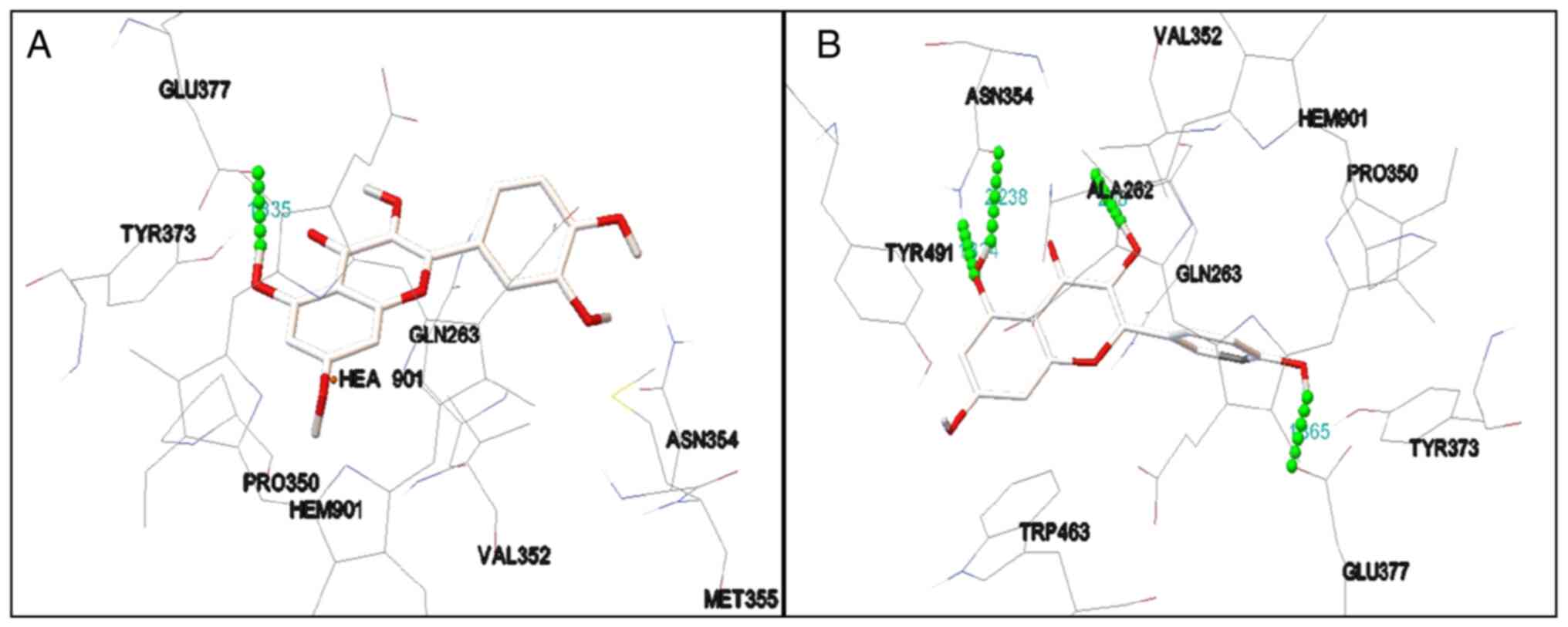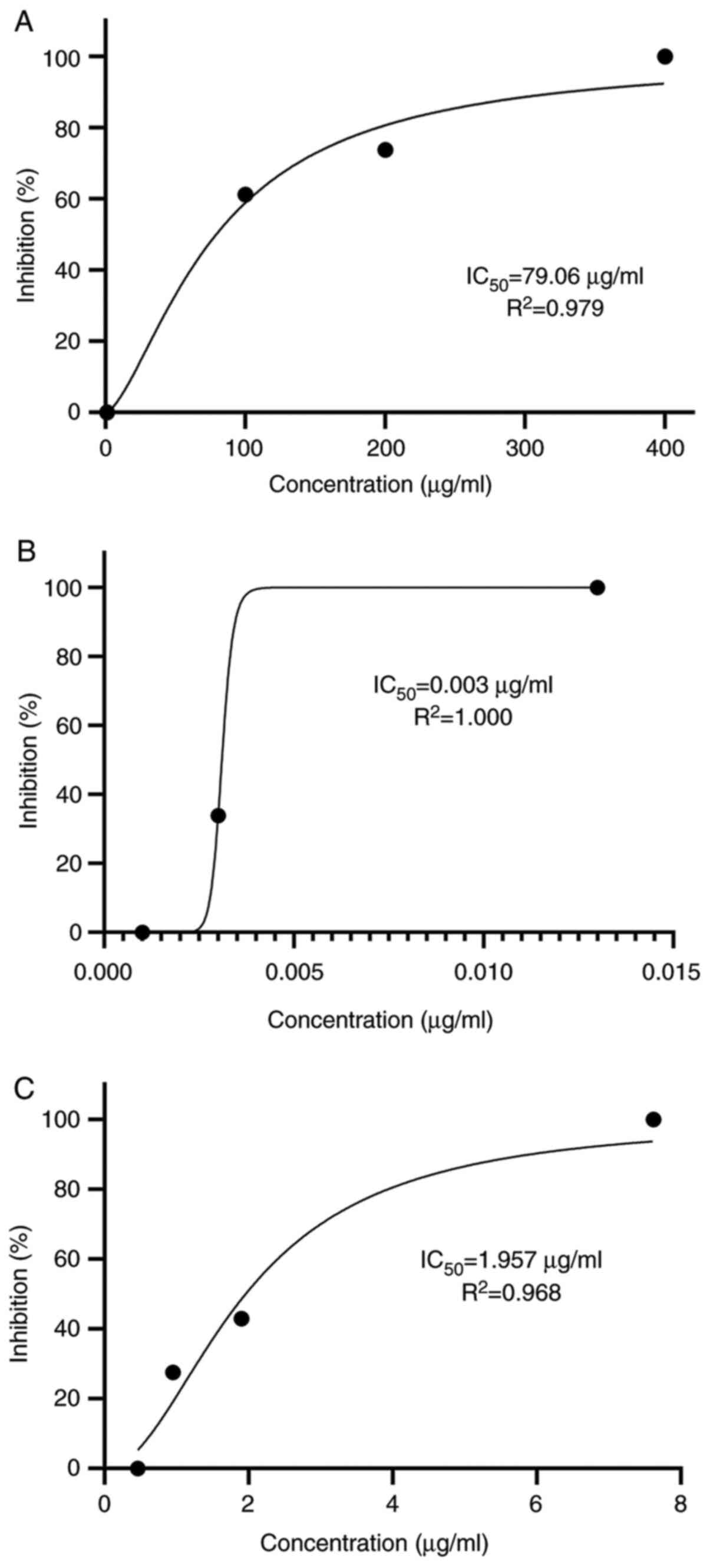|
1
|
Minhas R, Bansal Y and Bansal G: Inducible
nitric oxide synthase inhibitors: A comprehensive update. Med Res
Rev. 40:823–855. 2020.PubMed/NCBI View Article : Google Scholar
|
|
2
|
Cauwels A: Nitric oxide in shock. Kidney
Int. 72:557–565. 2007.PubMed/NCBI View Article : Google Scholar
|
|
3
|
Ghosh DK and Salerno JC: Nitric oxide
synthases: Domain structure and alignment in enzyme function and
control. Front Biosci. 8:d193–d209. 2003.PubMed/NCBI View
Article : Google Scholar
|
|
4
|
Giroud C, Moreau M, Mattioli TA, Balland
V, Boucher J, Xu-Li Y, Stuehr DJ and Santolini J: Role of arginine
guanidinium moiety in nitric-oxide synthase mechanism of oxygen
activation. J Biol Chem. 285:7233–7245. 2010.PubMed/NCBI View Article : Google Scholar
|
|
5
|
Punathil T and Katiyar SK: Inhibition of
non-small cell lung cancer cell migration by grape seed
proanthocyanidins is mediated through the inhibition of nitric
oxide, guanylate cyclase, and ERK1/2. Mole Carcinog. 48:232–242.
2009.PubMed/NCBI View
Article : Google Scholar
|
|
6
|
Lunn CA, Dolphin E, Prongay AJ, Reichert
P, Lundell DJ, Narula SK and Weber PC: Structural characterization
of nitric oxide synthase isoforms reveals striking active-site
conservation. Nat Struct Biol. 6:233–242. 1999.PubMed/NCBI View
Article : Google Scholar
|
|
7
|
Levita J, Patala R, Kolina J, Milanda T,
Mutakin M, Puspitasari IM, Saptarini NM and Sumiwi SA:
Pharmacophore modeling and molecular docking of phytoconstituents
in Morus sp. and Arcangelisia flava against nitric oxide synthase
for antiinflammatory discovery. J Applied Pharm Sci. 8:053–059.
2018.
|
|
8
|
Sudsai T, Wattanapiromsaku C and Tewtrakul
S: Inhibition of nitric oxide production by compounds from
Boesenbergia longiflora using lipopolysaccharide-stimulated
RAW264.7 macrophage cells. Songklanakarin J Sci Technol.
35:317–323. 2013.
|
|
9
|
Rosdianto AM, Puspitasari IM, Lesmana R
and Levita J: Determination of quercetin and flavonol synthase in
Boesenbergia rotunda rhizome. Pak J Biol Sci. 23:264–270.
2020.PubMed/NCBI View Article : Google Scholar
|
|
10
|
Rosdianto AM, Puspitasari IM, Lesmana R
and Levita J: Inhibitory activity of Boesenbergia rotunda
(L.) Mansf. rhizome towards the expression of Akt and NF-kappaB p65
in acetic acid-induced Wistar rats. Evid Based Complement Alternat
Med. 2020(6940313)2020.PubMed/NCBI View Article : Google Scholar
|
|
11
|
Salama SM, Bilgen M, Al Rashdi AS and
Abdulla MA: Efficacy of Boesenbergia rotunda treatment
against thioacetamide-induced liver cirrhosis in a rat model. Evid
Based Complement Alternat Med. 2012(137083)2012.PubMed/NCBI View Article : Google Scholar
|
|
12
|
Tewtrakul S, Subhadhirasakul S, Karalai C,
Ponglimanont C and Cheenpracha S: Anti-inflammatory effects of
compounds from Kaempferia parviflora and Boesenbergia
pandurata. Food Chem. 115:534–538. 2009.
|
|
13
|
Garcin ED, Arvai AS, Rosenfeld RJ, Kroeger
MD, Crane BR, Andersson G, Andrews G, Hamley PJ, Mallinder PR,
Nicholls DJ, et al: Anchored plasticity opens doors for selective
inhibitor design in nitric oxide synthase. Nat Chem Biol.
4:700–707. 2008.PubMed/NCBI View Article : Google Scholar
|
|
14
|
Fischmann TO, Hruza A, Niu XD, Fossetta
JD, Lunn CA, Dolphin E, Prongay AJ, Reichert P, Lundell DJ, Narula
SK and Weber PC: Structural characterization of nitric oxide
synthase isoforms reveals striking active-site conservation.
Structural characterization of nitric oxide synthase isoforms
reveals striking active-site conservation. Nat Struct Biol.
6:233–242. 1999.PubMed/NCBI View
Article : Google Scholar
|
|
15
|
Contu S: Boesenbergia rotunda. The IUCN
Red List of Threatened Species. 2013(e.T44392164A44540996)2013.
|
|
16
|
Tiwari P, Kumar B, Kaur M, Kaur G and Kaur
H: Phytochemical screening and extraction: A review. Internationale
Pharmaceutica Sciencia. 1:98–106. 2011.PubMed/NCBI View Article : Google Scholar
|
|
17
|
Neidle S (ed): Design principles for
quadruplex-binding small molecules in therapeutic applications of
quadruplex nucleic acids. Academic Press, Cambridge, MA, pp151-174,
2012.
|
|
18
|
Pasha A, Kumbhakar DV, Doneti R, Kumar K,
Dharmapuri G, Poleboyina PK, Heena SK, Basavaraju P, Pasumarthi D,
Annapurna SD, et al: Inhibition of inducible nitric oxide synthase
(iNOS) by andrographolide and in vitro evaluation of its
antiproliferative and proapoptotic effects on cervical cancer. Oxid
Med Cell Longev. 2021(6692628)2021.PubMed/NCBI View Article : Google Scholar
|
|
19
|
Ferreira EI and Serafim RAM: Nitric oxide
synthase inhibitors. In: Nitric Oxide Synthase-Simple
Enzyme-Complex Roles [Internet]. Saravi SSS (ed). IntechOpen,
London, 2017.
|
|
20
|
Arias F, Franco-Montalbana F, Romero M,
Duarte J, Carrióna MD and Camacho ME: Bioactive imidamide-based
compounds targeted against nitric oxide synthase. Bioorg Chem.
120(105637)2022.PubMed/NCBI View Article : Google Scholar
|
|
21
|
Jing L, Mohamed M, Rahmat A and Abu BM:
Phytochemicals, antioxidant properties and anticancer
investigations of the different parts of several gingers species
(Boesenbergia rotunda, Boesenbergia pulchella var
attenuata and Boesenbergia armeniaca). J Med Plants
Res. 4:27–32. 2010.
|
|
22
|
Indrayanto G, Putra GS and Suhud F:
Validation of in vitro bioassay methods: Application in herbal drug
research. Profiles Drug Subst Excip Relat Methodol. 46:273–307.
2021.PubMed/NCBI View Article : Google Scholar
|
|
23
|
Dikalov S: Cross-talk between mitochondria
and NADPH oxidases. Free Radic Biol Med. 51:1289–1301.
2011.PubMed/NCBI View Article : Google Scholar
|
|
24
|
García-Mediavilla V, Crespo I, Collado PS,
Esteller A, Sánchez-Campos S, Tuñón MJ and González-Gallego J: The
anti-inflammatory flavones quercetin and kaempferol cause
inhibition of inducible nitric oxide synthase, cyclooxygenase-2 and
reactive C-protein, and down-regulation of the nuclear factor
kappaB pathway in chang liver cells. Eur J Pharmacol. 557:221–229.
2007.PubMed/NCBI View Article : Google Scholar
|
|
25
|
Ibrahim MB, Sowemimo AA, Sofidiya MO,
Badmos KB, Fageyinbo MS, Abdulkareem FB and Odukoya OA: Sub-acute
and chronic toxicity profiles of Markhamia tomentosa ethanolic leaf
extract in rats. J Ethnopharmacol. 193:68–75. 2016.PubMed/NCBI View Article : Google Scholar
|
|
26
|
Sini S, Latha PG, Anilkumar TV, Suja SR,
Raj G, Rameshkumar KB, Shyamal S, Shine VJ, Anuja GI, Shikha P, et
al: Safety assessment of tuberous rhizome of Kaempferia
rotunda L. by acute and 28-days repeated dose toxicity studies.
Global J Pharmacol. 8:128–139. 2014.
|
|
27
|
Dabeek WM and Marra MV: Dietary quercetin
and kaempferol: Bioavailability and potential
cardiovascular-related bioactivity in humans. Nutrients.
11(2288)2019.PubMed/NCBI View Article : Google Scholar
|
|
28
|
Falkson SR and Bordoni B: in Anatomy,
Abdomen and Pelvis, Bowman Capsule. StatPearls Publishing LLC.
2022. Bookshelf ID: NBK554474 PMID: 32119361.
|
|
29
|
Akilesh S: Normal kidney function and
structure, in pathobiology of human disease. Academic Press,
Cambridge, MA, 2014.
|
|
30
|
National Toxicology Program. NTP
toxicology and carcinogenesis studies of Turmeric Oleoresin (CAS
No. 8024-37-1) (Major Component 79%-85% Curcumin, CAS No. 458-37-7)
in F344/N rats and B6C3F1 MIce (Feed Studies). Natl Toxicol Program
Tech Rep Ser. 427:1–275. 1993.PubMed/NCBI
|
|
31
|
Joshi J, Ghaisas S, Vaidya A, Vaidya R,
Kamat DV, Bhagwat AN and Bhide S: Early human safety study of
turmeric oil (Curcuma longa oil) administered orally in healthy
volunteers. J Assoc Physicians India. 51:1055–1060. 2003.PubMed/NCBI
|
|
32
|
Burgos-Moron E, Calderon-Montano JM,
Salvador J, Robles A and Lopez-Lazaro M: The dark side of curcumin.
Int J Cancer. 126:1771–1775. 2010.PubMed/NCBI View Article : Google Scholar
|
|
33
|
Saravanapriya P and Devi KP: Plant
extracts with putative hepatotoxicity activity. In: Influence of
Nutrients, Bioactive Compounds, and Plant Extracts in Liver
Diseases. Alavian SM, Nabavi SM, Nabavi SF and Silva AS (eds).
Academic Press, Tehran, pp259-287, 2020.
|
|
34
|
Sonmez A, Yilmaz MI, Mas R, Ozcan A,
Celasun B, Dogru T, Taslipinar A and Kocar IH: Subacute cholestatic
hepatitis likely related to the use of senna for chronic
constipation. Acta Gastroenterol Belg. 68:385–387. 2005.PubMed/NCBI
|
|
35
|
Yang B, Xie Y, Guo M, Rosner MH, Yang H
and Ronco C: Nephrotoxicity and Chinese herbal medicine. Clin J Am
Soc Nephrol. 13:1605–1611. 2018.PubMed/NCBI View Article : Google Scholar
|


















